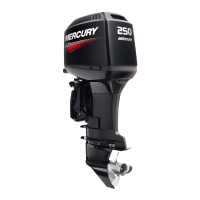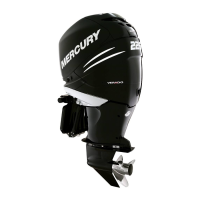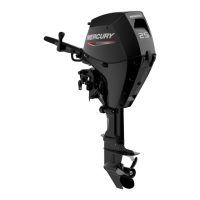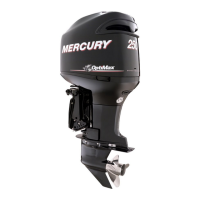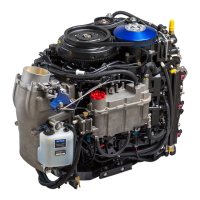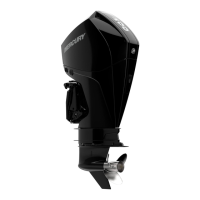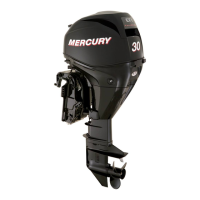90-10100R30
11
GB
gog4
a
og
FEATURES & CONTROLS
ogg1
SETTING THE OPERATING ANGLE OF YOUR
OUTBOARD
The vertical operating angle of your outboard is adjusted by changing the position
of the tilt pin (a) in the adjustment holes provided. Proper adjustment allows the
boat to run stable, achieve optimum performance, and minimize steering effort.
The tilt pin should be adjusted so the outboard is positioned to run perpendicular
to the water when the boat is running at full speed. This allows the boat to be driven
parallel to the water.
Arrange load and passengers in the boat so the weight is distributed evenly.
of
OPERATION
ofa1
PRE-STARTING CHECK LIST
j Operator knows safe navigation, boating, and operating procedures.
j An approved personal flotation device of suitable size for each person aboard
and readily accessible (it is the law).
j A ring type life buoy or buoyant cushion designed to be thrown to a person in
the water.
j Know your boats maximum load capacity. Look at the boat capacity plate.
j Fuel supply OK.
j Arrange passengers and load in the boat so the weight is distributed evenly and
everyone is seated in a proper seat.
j Tell someone where you are going and when you expect to return.
j It is illegal to operate a boat while under the influence of alcohol or drugs.
j Know the waters and area you will be boating; tides, currents, sand bars, rocks,
and other hazards.
j Make inspection checks listed in the Inspection and Maintenance Schedule.
Refer to Maintenance Section.
onf2
OPERATING IN FREEZING TEMPERATURES
When using your outboard or having your outboard moored in freezing or near
freezing temperature, keep the outboard tilted down at all times so the gear case
is submerged. This prevents trapped water in the gear case from freezing and
causing possible damage to the water pump and other components.
If there is a chance of ice forming on the water, the outboard should be removed
and drained completely of water. If ice should form at the water level inside the
outboard drive shaft housing, it will block water flow to the engine causing possible
damage.
one3
OPERATING IN SALT WATER OR POLLUTED WATER
We recommend that you flush the internal water passages of your outboard with
fresh water after each use in salt or polluted water. This will prevent a buildup of
deposits from clogging the water passages. Refer to “Flushing The Cooling
System” procedure in the Maintenance Section.
If you keep your boat moored in the water, always tilt the outboard so the gear case
is completely out of water (except in freezing temperature) when not in use.
Wash down the outboard exterior and flush out the exhaust outlet of the propeller
and gear case with fresh water after each use. Each month, spray Mercury
Precision or Quicksilver Corrosion Guard on external metal surfaces (do not spray
on corrosion control anodes as this will reduce the effectiveness of the anodes).
ofd1
ENGINE BREAK-IN PROCEDURE
CAUTION
Severe damage to the engine can result by not complying with the
Engine Break-in Procedure.
Engine Break-in Fuel Mixture
Use a 25:1 (4%) gasoline/oil mixture in the first tank of fuel.
Engine Break-in Procedure
Vary the throttle setting during the first hour of operation. During the first hour of
operation, avoid remaining at a constant speed for more than two minutes and
avoid sustained wide open throttle.
gof1
123
ofe1
STARTING THE ENGINE
Before starting, read the Pre-Starting Check List, Special Operating Instructions,
and Engine Break-in Procedure on the first three pages in the Operation Section.
CAUTION
Never start or run your outboard (even momentarily) without water
circulating through the cooling water intake in the gear case to prevent
damage to the water pump (running dry) or overheating of the engine.
1 Lower the outboard to the run position. Make sure the cooling water intake is
submerged.
2 Open fuel tank vent.
3 Open the fuel cock knob.
gof2
4
5-6
a
b
ofe35
STARTING THE ENGINE
4 Attach the lanyard to the stop switch. Read the Lanyard Stop Switch safety
explanation and Warning in the General Information Section.
Note: The engine will not start unless the lanyard is engaged with the stop switch.
5 If engine is cold, move choke level (a) to closed (up) position. Move halfway down
as engine is warming up. Move down to the open position after engine is warmed
up.
6 Move the throttle level (b) to the start position.

